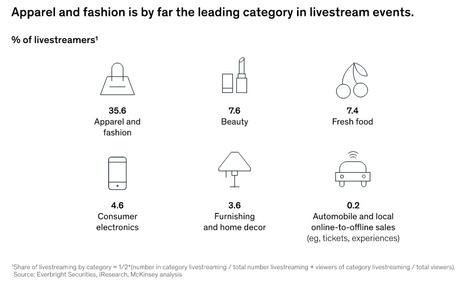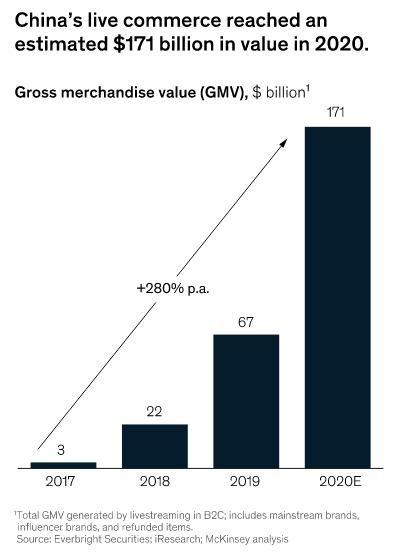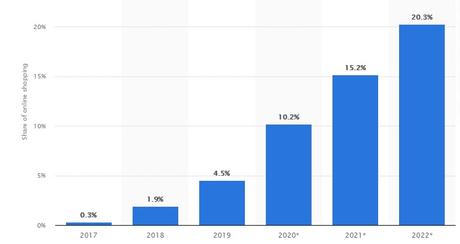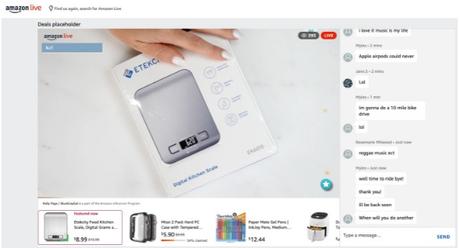The business model in which influencers, retailers, or celebrities sell products and services using online video streaming is live ecommerce.
Here the presenter displays, demonstrates and discusses what's on offer and clears queries in real-time too. This can be incorporated in ecommerce websites and social media apps.
A livestream session could occur on an ecommerce website or a social media platform. It can be brand or store specific. Influencers can host livestream sessions promoting goods of various vendors.
Live ecommerce is going great guns in China. The industry earns around $60 billion annually. 36% of the online shoppers made livestream purchases in China last year. Taobao's Annual Day Global Shopping Festival livestream raked in $6 billion in sales. Double in comparison to the previous year.

This trend is spreading from China, to the West and other countries. TikTok collaborated with Walmart and presented the first livestream selling event a year back. Ten influencers promoted Walmart products with try-on display during the hour long event. People could browse the list of featured items and place orders directly from within TikTok as the event progressed.
Amazon has also launched a live platform wherein influencers promote items and chat with budding customers.Facebook and Instagram are exploring the integration of ecommerce and social media. The new Shop feature on Instagram allows users to browse products and place orders directly within Instagram - known as social commerce.
Anatomy of a Livestreaming Session
Basic Livestream Interface Components
A conventional livestream session has the following components:
- The video stream, where a host shows products, talks about them, and answers questions from the audience.
- The list of products being promoted, with the product currently being shown highlighted
- A chat area, for viewers to type their questions and comments so as to interact with the host and other viewers
- A reaction button for users to send reactions, displayed via animated emojis
More Livestream Features in Chinese Apps
Besides these regular features, a live ecommerce interface in Chinese apps normally includes additional components such as:
- Picture-in-picture view of the live session on the current product's detail page. Customers can go to the product-detail page of a promoted product without missing the livestream demo which can be viewed in a picture-in-picture format.
- The ability to watch the presentation of those products they are interested in: Viewers can watch recorded demonstrations of previously shown products. But in case the products are on the featured-product list without any demonstrations, they can request the host to show that product. Thus, the livestream has an on-demand constituent if viewers are interested in particular products, those get priority.
Viewers are encouraged to check for coupons before purchasing. Some coupons are available immediately after users enter the session; others require more engagement, like after 10 minutes of watching the presentation or sharing the session with 3 contacts. The host can decide discount amount for each coupon.
Each viewer has a loyalty level representative of their past participation in that host's livestreams. Watching, commenting, and making purchases can increase this level. Loyalty level is displayed next to the username when the viewer makes comments. Some hosts reserve high-value coupons for loyal viewers.
Key Characteristics of Live Ecommerce
Livestream ecommerce has several unique features:
- Integrated into various platforms: Most livestream sessions don't rely on new platforms, apps, or services, but takes advantage of popular platforms.
- Mimics in-store shopping experiences by showing products in context: Customers can see the host showcase the products from different angles and request an outfit to be tried on by a specific model.
- Highly interactive, social, and playful with gamification: Users can interact with the host and other people watching a session, getting their questions and concerns answered. Additional offers like coupons and giveaways are utilized sporadically to increase engagement, and the host tries to create a joyous environment. Participants can wind down during a session and encourages them to come back.
- Often reliant on scarcity and urgency: Users feel that they will lose the deal if they don't place an order during the livestream, because it offers good discounts and limited stock.
Integrated into Platforms
Brands and individuals have two ways to promote products through livestreaming: on social media or ecommerce platforms. No matter which platform they use, the livestream channel is naturally integrated into the platform's fundamental features.
In traditional ecommerce apps when users search for products, a list will depict those featured in live ecommerce sessions. This is done using a specially animated icon indicating that an ongoing livestream is in progress for the said product.

On social media platforms such as Douyin a specialized Livestream channel features on the homepage. This works similar to other content on Douyin. Viewers can also swipe up to check out a different live ecommerce session that is available as a Livestream feature.
Show the Product Dynamically and in Context
Livestream sessions show users what products look like, how to use and style them, and even how they're made.
Livestreaming can introduce a new brand and highlight its credibility. Influencers selling local products may host live ecommerce sessions elucidating the products origin and how the locals consume these products before they start selling. This procedure helps urban dwellers to build trust on SMEs and products from rural regions.
Highly Interactive and Social
Livestream sessions are similar to product videos in the manner that they show product details from close. Some retailers may even feature livestream clips as product videos on product-detail pages. The difference being, livestreams are interactive. Users prefer livestreaming over product videos because they can have an interaction and get their queries cleared immediately.

The interactivity makes livestreaming a highly efficient way to learn about products and get questions answered at the same time. It's similar to walking into a physical store where the host greets you shows you the products you are interested in, they may even provide recommendations. Though users can't talk with the host directly, they can send text messages, which show up in the chat history for everyone in the session. There could be multiple models performing demo of clothes. Users can request a specific model to wear a particular outfit to fathom their in-store try-on experience.
Personal, specific questions that may not be anticipated or covered on the product-detail page can get answered quickly. The answers to one customer may benefit others, as well.
In certain situations an ad-hoc community forms around a sequence of livestream sessions. Followers or influencers become a loyal for their livestream events. They assist the host by providing answers to regular questions and share their experience as well. This would add credibility to the brand or product. These are the real users and their opinion matters. Such users may have a badge attached to their username, indicating the time spent in the session and the purchases made. Returning users are rewarded with coupons and incentives.
Live comments enable sellers to determine products that are popular and ensure supplies are available.
Create a Sense of Scarcity and Urgency
Some livestream events utilize psychological techniques to create a sense of urgency: they make the customers believe that they will lose out if they don't move immediately.
- Greater discounts and more gifts: Products may be available all through the year, but discounts and gifts are available exclusively for people attending the livestream session. To distinguish the loyal livestream viewers from ordinary users who just run into a discounted product accidentally, some companies may require livestream viewers to enter a unique 'promo code' when placing the order to get even more gifts and cashback. The promo code would be announced randomly during a livestream session, thus it would encourage users to linger along. This practice also helps users form the mental model that livestreaming equals special discounts and gifts.
- Limited Stock: Discounted products usually have limited stock. The host might emphasize, "There're only 10,000 sets available at this crazy price."
- Time-sensitive coupons: Many livestream sessions give out 10-20 coupons that expire in a few hours. This approach induces users to make quick, impulsive purchases.
- Incentives and giveaways for users who made a purchase during the livestream event. The host will sometimes announce surprise giveaways only for those viewers who bought something. These tactics make the users even more motivated to purchase.
Social Commerce vs. Live Ecommerce
Social-media platforms like Facebook or Instagram offer clients the facility to make purchases right there without switching to a dedicated ecommerce channel is coined as social commerce. Instagram and Facebook Shop feature enables users to order directly from within the platform.
Live ecommerce is similar to social-media commerce if and when the livestream is embedded within the social-media platform. The live video is different from other common formats used in social ecommerce, but it is similar to the one that can be accommodated on a social-media platform.
Social commerce supports in-channel purchases while lowering interaction cost. Livestreams create a sense of urgency by offering time-sensitive offers for clients unlike social commerce.
But not all livestream ecommerce is social commerce, as livestreams can be embedded on ecommerce sites and apps. But on such channels, livestream ecommerce include social features such as customer comments or reactions. Livestreams are usually advertised on social media.


